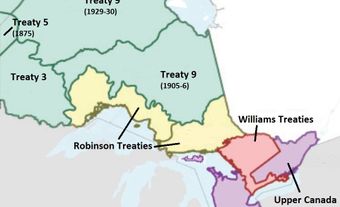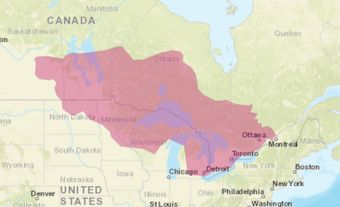Ajax, Ontario, incorporated as a town in 1955, population 119,677 (2016 census), 109,600 (2011 census). The town of Ajax is located 13 km from the eastern boundary of Toronto on the north shore of Lake Ontario. Ajax became part of the Regional Municipality of Durham in October 1973. In January 1974, Ajax expanded to include the village of Pickering (incorporated 1953) and part of Pickering Township.
Indigenous Peoples and Treaties
Ajax is located on the traditional territory of the Huron-Wendat, Haudenosaunee and Mississauga (see Anishinaabe). At the time of European settlement, it was the Mississauga who inhabited the north shore of Lake Ontario, including what would become Ajax.
White settlers began to occupy the area in the 19th century. For example, the earliest settlers in Pickering Village arrived in 1802. In 1923, commissioners representing the provincial and federal governments hastily arranged two treaties in order to extinguish the Mississauga’s title to the land. Known collectively the Williams Treaties, the document pertaining to the Ajax area was signed in November 1923. It included four Mississauga First Nations: Alderville, Mud Lake (now known as Curve Lake), Rice Lake (now known as Hiawatha) and Scugog Lake.
Development

Munitions manufacturing in Ajax, Ontario, c 1940─1945.
Ajax was established in 1941 to service a munitions plant built on a 1,200 ha site. It was named for one of the two British Leander-class cruisers that cornered the German pocket battleship Graf Spee in 1939. The streets within the town bear the names of the servicemen who worked on the HMS Ajax and its sister ship the HMS Achilles.
After the Second World War, 7,300 returned servicemen took engineering courses offered in Ajax by the University of Toronto. After the Ajax campus closed, the site became home to thousands of refugees from post-war Europe. The “displaced persons (DP)” camp was in operation from 1949 to 1953. After its closure, the Central Mortgage and Housing Corporation announced that Ajax would be Canada’s first fully-planned industrial and residential centre.
Population
Today, like many communities in the Greater Toronto Area, Ajax’s population is ethnically diverse. According to the 2016 census, large ethnic groups living within the town include South Asian people (20.9 per cent of the population), Black people (16.7 per cent), Filipino people (4.8 per cent) and Chinese people (2.9 per cent). The majority of immigrants living in Ajax cite their country of birth as Jamaica, followed by Sri Lanka, India, the Philippines and Pakistan. Indigenous peoples make up 1 per cent of Ajax residents.
Economy and Cultural Life
Today the town is a light industrial centre. Ajax also functions as a bedroom community for Toronto. Several of its 19th century buildings have been preserved including the Quaker Meeting House (c 1867) and a hotel (c 1850). This area now houses restaurants and quaint shops.

 Share on Facebook
Share on Facebook Share on X
Share on X Share by Email
Share by Email Share on Google Classroom
Share on Google Classroom



